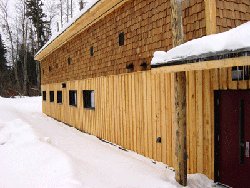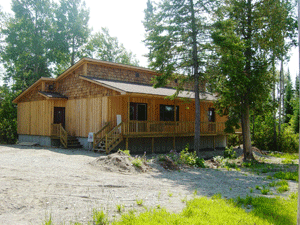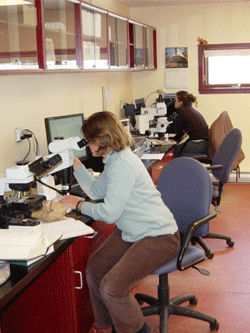Lake Duparquet Research Station
LAKE DUPARQUET RESEARCH AND TEACHING FOREST RESEARCH STATION IS AN ACADEMIC
INFRASTRUCTURE WHICH FIRST MISSION IS TO FACILITATE ACQUISITION OF KNOWLEDGE
IN BOREAL FOREST SCIENCE AND RELATED SCIENTIFIC FIELDS.
An investment of 2 M$ from provincial department of Economic Development,
Innovation and Export Trade (former department of Research, Science and
Technology) allowed for Phase I construction. Additional contributions of 125 K$ each from
Canada Foundation for Innovation (CFI) and from the Ministère de l’Éducation,
du Loisir et du Sport (MESL) were directly directed to construction costs.
Industrial partners also contributed by providing material, instrumentation
and plans: Norbord OSB, Tembec, Domtar, Matériaux Blanchet, Landrienne
Sawmill, Honeywell, Abitibi-Consolidated, Trame and Selbaie Mines.
Lake Duparquet Research Station has been built to:
- Support researchers and students working in boreal forest science at the
Lake Duparquet Research and Teaching Forest and elsewhere in the region in
their field and laboratory work;
- Ensure functionality and conviviality of work places as well as an access
to leading edge laboratory equipment for researchers and students;
- Provide with an infrastructure for educational purposes, especially in
forest sciences at academic and other levels, if necessary;
- Provide with a welcoming place for regional meetings as well as for national
and international scientific forums.
LAKE DUPARQUET RESEARCH AND TEACHING FOREST RESEARCH STATION, FOLLOWING
THE EXAMPLE OF THE UNIVERSITÉ DU QUÉBEC NETWORK, PARTICULARLY
UQAT AND UQAM, IS OPEN TO ITS SURROUNDING MILIEU AND IS A WELCOMING PLACE
FOR REGIONAL MEETINGS AS WELL AS FOR NATIONAL AND INTERNATIONAL SCIENTIFIC FORUMS.
PHASE I
Projects of building a research station at the LDRTF started at the end
of the 1990s. At that time, an increasing number of students was presenting
some work place and lodging challenges. With a significant financial help
from Economic Development, Innovation and Export Trade provincial department, Ministère
de l’Éducation, du Loisir et du Sport (MELS) and Canada Foundation
for Innovation (CFI), Phase I was completed in 2005. Another grant from CFI
and from Research, Science and Technology provincial department allowed for
the purchase of scientific equipment (for field and laboratory) and station’s
furniture. Tembec, Norbord, Domtar, Matériaux Blanchet, Landrienne
Sawmill, Honeywell, Abitibi-Consolidated, Trame and Selbaie Mines gave
the bulk of construction material and research station equipment.
PHASE I INAUGURATION
On September 9, 2006, 110 persons attended the inauguration of Phase I
of the Research Station, which is composed of four housing blocks. Mr.
Pierre Corbeil, Québec’s Minister of Natural Resources and Wildlife, Mr. Daniel
Rancourt, prefect of the MRC Abitibi-Ouest, Ms. Johanne Jean, UQAT rector,
Mr. Roch Denis, UQAM rector, Mr. Roger Gauthier, president of the administration
board of UQAT, and Mr. Brian Harvey, director of the LDRTF, have together
cut the red ribbon.
WOOD: A UNIQUE CONSTRUCTION AND ASPECT MATERIAL
 We insisted that wood be used for construction and finishing of the Research
Station. Almost all woody material used for the construction of the station
came from the region, and part of it even came from the LDRTF. A variety
of wood types was used for floor, walls and ceiling covering. Floor in the
multiuse pavilion is particularly astonishing. It was made of drown wood fished out
of Lake Des Quinze, which gives it pale and dark shades. Finishing material
used outdoor also came from the bottom of that lake. We insisted that wood be used for construction and finishing of the Research
Station. Almost all woody material used for the construction of the station
came from the region, and part of it even came from the LDRTF. A variety
of wood types was used for floor, walls and ceiling covering. Floor in the
multiuse pavilion is particularly astonishing. It was made of drown wood fished out
of Lake Des Quinze, which gives it pale and dark shades. Finishing material
used outdoor also came from the bottom of that lake.
PHASE II
Inaugurated September 20, 2010, the phase II includes an addition built onto the dendroecology laboratory and a new housing lodge. Providing homey accommodation for 10, the « Pavillon Desjardins Abitibi-Ouest » has been so-named in recognition of the generous gift provided by the Caisses Desjardins of the sector. The new space in the dendro lab will add work stations and equipment for wood density and isotopic analyses used primarily for dendroclimatological studies. The new infrastructures are also funded by the Government of Québec and the Canada Foundation for Innovation.

Desjardins Abitibi-Ouest lodge
|
 |
 With the Research Station, students and researchers can carry on their research
works while leaving on the LDRTF area. Access to desktop and Internet connexions
is possible in all pavilions by cable and/or WIFI. For now, the Station is composed of four blocks: With the Research Station, students and researchers can carry on their research
works while leaving on the LDRTF area. Access to desktop and Internet connexions
is possible in all pavilions by cable and/or WIFI. For now, the Station is composed of four blocks:
Building A (community block)
This block presents a multiuse room (40-70 people’s capacity) with a
fireplace, a classroom (25 people’s capacity), a well-equipped kitchen
and a huge patio with an impressive view on Lake Hébécourt.
Please consult evacuation plan of building A in case of emergency ground-floor 1  , ground-floor 2 , ground-floor 2  , basement , basement . .
Building B (lodging block)
This block incorporates 11 bedrooms (double and triple occupation), one of
them being adapted for handicapped people and for families, one living room,
one laundry room, one drying room and washrooms. All rooms are equipped with
a desktop connexion and an Internet access. We can now welcome up to 35-40 people with the addition of phase II.
Please consult evacuation plan of building B in case of emergency ground-floor 1  , ground-floor 2 , ground-floor 2  . .
Building C (DendroEcology laboratory)
 The Dendroecology
laboratory includes spaces and equipments necessary for
the preparation and analysis of wood samples. It includes: The Dendroecology
laboratory includes spaces and equipments necessary for
the preparation and analysis of wood samples. It includes:
- a sanding room
- a image analysis system, with a microscope, a digital camera, a high
resolution scanner and many specialized softwares (WinCELL, WinDENDRO,
WinFOLIA, WinRHIZO, WinSEEDLE, WinSTEM and FHX Fire History
Analysis software)
- 3 Velmex systems
- a rotary Microton, for automatic tissue sectioning.
Also, an air-conditioned storehouse allows for long term conservation of
samples. Samples of most of the dendroecology studies conducted in the
region since de 1980s are stored in that room. Finally, this pavilion incorporates
work stations for students and trainees. For more information, please
contact
Fabio Gennaretti (fabio.gennaretti@uqat.ca)
or visit the laboratory website at https://dendro.uqat.ca/. Please consult evacuation plan of building C  in case of emergency. in case of emergency.
Paleoecology laboratory
In 2010, an extension of the laboratory of dendroecology allowed the addition of two rooms dedicated to paleoecology. Microscope, binocular loupes, sieve, refrigerator and freezer find their place. Many sediment collection probes are also available (kajak, Russian, Livingstone).
 In both cases, these laboratories contribute to the participation of UQAT and UQAM in the Cold Forest Research Group GDRI In both cases, these laboratories contribute to the participation of UQAT and UQAM in the Cold Forest Research Group GDRI
Building D (multiuse laboratory)
The Multiuse laboratory is composed of two laboratories for field samples
primary treatment. It is equipped with crushers for wood, vegetation or
soil samples, scales, binoculars, air ovens, refrigerators, freezers (- 80°C), incubators,
osmosis water treatment system, sinks and enough work surface. A meeting
room and workspaces are also located in this pavilion. Please consult evacuation plan of building D  in case of emergency. in case of emergency.
Pavillon E (Desjardins Abitibi-Ouest)
Please consult evacuation plan of building E  in case of emergency. in case of emergency.
The Lake Duparquet Research Station offers, during some periods of the year,
the possibility of renting a room including 3 meals, at modest price. It
is also possible to rent a room for a meeting, a course, or any social happening.
For more information or to make a reservation, please contact Yvan Poirier (yvan.poirier@uqat.ca), office number (819) 762-0971 ext. 2055 and mobile : (819) 277-8442. Please consult the pricing grid.
HOW TO GET THERE
If you come from (see map 1; map 2):
- Kirkland Lake (Ontario): route 66 becomes route 117 in Québec.
Follow route 117 south to Rouyn-Noranda, and take the turn off for route
101 North towards La Sarre in the outskirts of Rouyn. At the junction with route
393 follow the signs for Duparquet (turn to the left). In Duparquet, at the
stop sign turn right and then at the junction with route 388 turn left towards
Matheson (Ontario). Turn left at the sign on the highway that announces the
research station.
- Toronto, North Bay, New Liskeard (Ontario) : From Ont. Highway 11, take
the last exit for New Liskeard towards route 65 east towards the province
of Québec. Continue on Highway 65 until Notre-Dame du Nord in Québec.
At the T-junction take a left onto route 101, north towards Rouyn-Noranda.
Continue north, route 101 will join route 117. Watch for the turn off towards
La Sarre where route 101 separates in the outskirts of Rouyn. Head towards
LaSarre on route 101. At the junction with route 393 follow the signs for
Duparquet (turn to the left). In Duparquet, at the stop sign turn right and
then at the junction with route 388 turn left towards Matheson (Ontario). Turn left at
the sign on the highway that announces the research station.
- Timmins (Ontario): route 101 (Ontario) becomes route 388 in Québec.
Turn right at the sign on the highway that indicates the research station.
- Montréal (Québec): Take highway 15 north towards Mont-Laurier.
It becomes highway 117 North. Follow signs to Rouyn-Noranda. In the city
of Rouyn, the 117 will become Avenue Larivière. Follow signs towards
route 101 north towards La Sarre. From route 101, turn left on route 393
towards Duparquet. At the stop sign turn right and then at the junction with
route 388 turn left towards Matheson (Ontario). Turn left at the sign on
the highway that announces the research station.
Address of the research station: 488 chemin Balbuzard, Rapide-Danseur, J0Z 3G0.

|